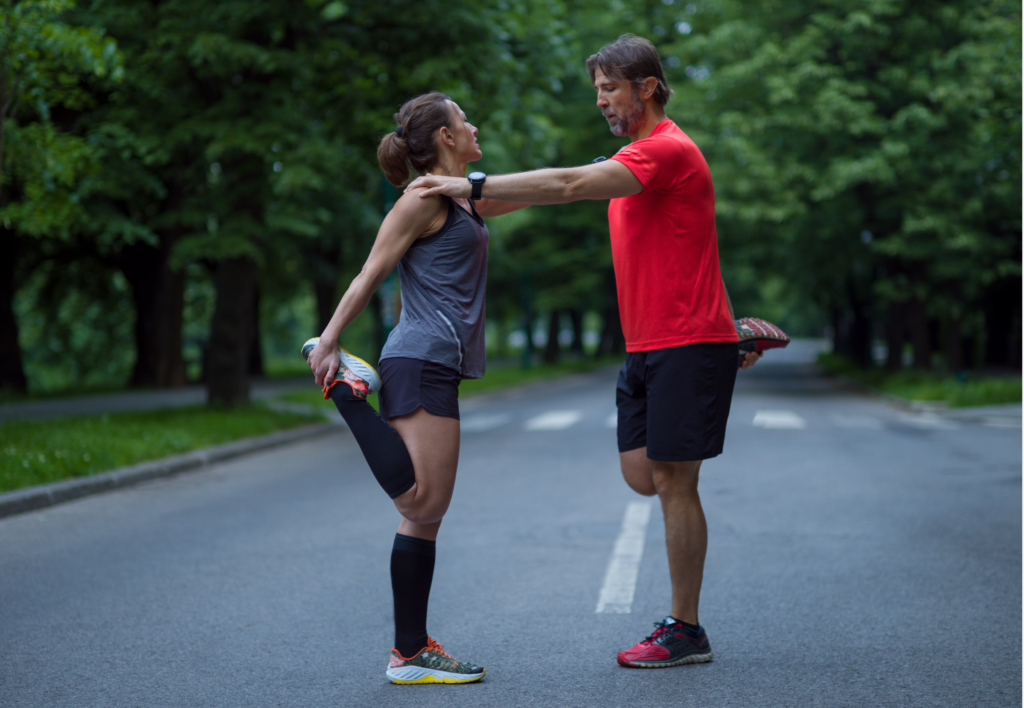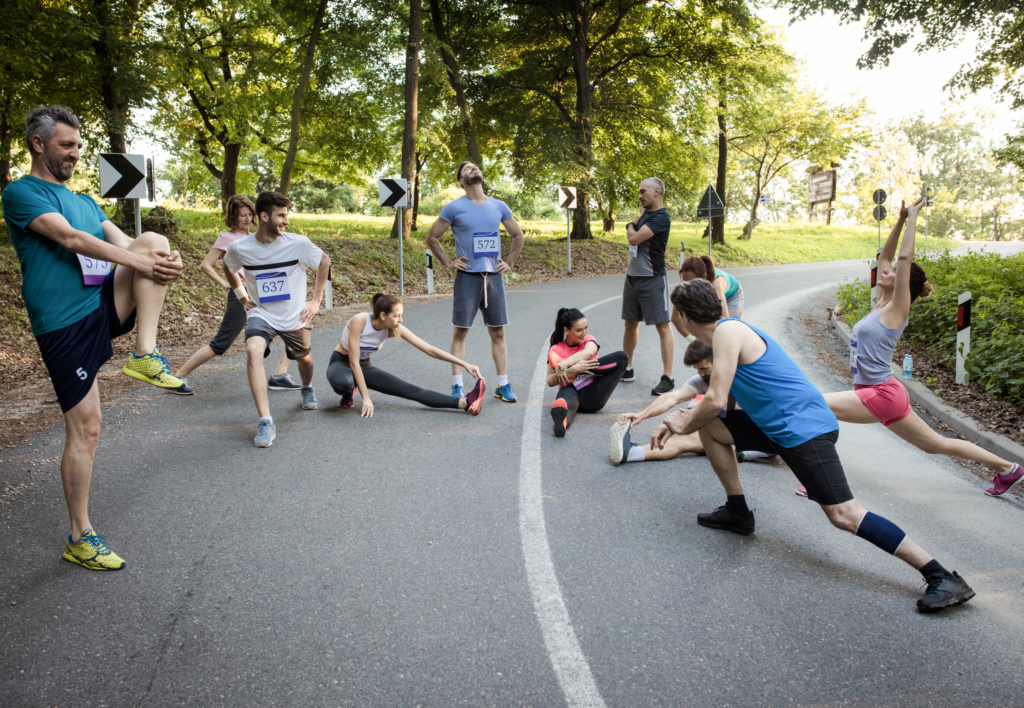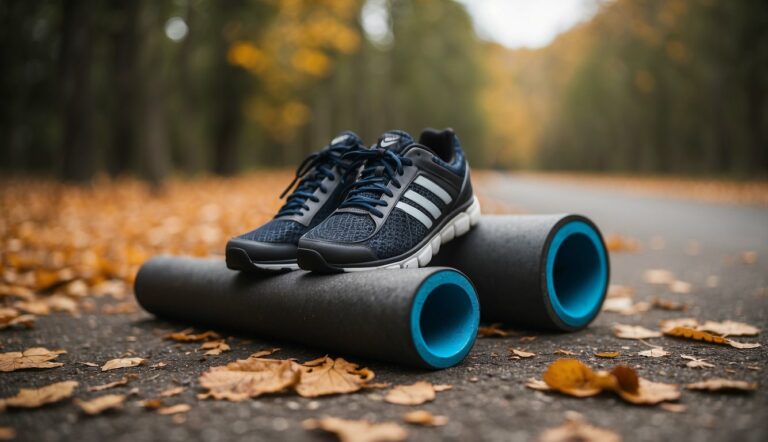Pre-race Warm-up Routine for Runners – How To Get the Most Out of Race Day!
A pre-race warm-up is crucial for every runner to enhance performance and prevent injury, and it starts with a balance between raising your heart rate and conserving energy.
Your warm-up routine kicks off with gentle walking or jogging, which serves to increase muscle temperature and blood flow without sapping the vigor you’ll need for the race. As you progress, the intensity should gradually build to near race pace, especially for shorter distances, ensuring your body is primed for the effort ahead.
Equally important to the physical is the mental preparation. During your warm-up, visualize the race, and establish a strategy, this mental prep helps in setting a focused and competitive mindset.
Remember that your warm-up is personal; it should be tailored to your body’s needs and the demands of the race you’re about to tackle. Whether it’s a 5K or a marathon, a bespoke warm-up routine will optimize your performance when you line up at the start.
Dynamic Pre-Race Warm-Up Exercise Routine
Before you toe the starting line, prime your muscles and joints with dynamic pre-race warm-up exercises. These movements enhance flexibility, increase blood flow, and prepare your body to perform at its best from the moment you start racing.
Upper Body Mobilization
Your upper body plays a crucial role in maintaining balance and rhythm while running.
- Arm Circles: Stand tall and extend your arms out to your sides. Rotate your arms in small circles, gradually increasing the size. Perform 10-15 circles in each direction.
- Hip Opener with Arm Swing: Use hip opener exercises to loosen the hip joint with arm swings to mobilize your shoulders. Swing one arm forward and the other back, alternating with each hip opener. Repeat this movement 8-10 times on each side.
Lower Body Mobilization
Dynamic lower body exercises ensure your legs are ready to carry you efficiently.
- Frankenstein Walk: With straight legs, kick one foot up towards your hand at waist height, alternating legs as you walk forward. Do this for about 15 seconds moving forward.
- Leg Swings: Stand on one leg, swing the other leg forward and back, then side to side. This helps to loosen the hip flexors and hamstrings. Aim for 10 swings in each direction per leg.
- High-Knees: Jog in place, driving your knees up towards your chest as high as possible. Continue for 20-30 seconds.
- Butt Kicks: Run in place, kicking your heels up towards your glutes. Perform for 20-30 seconds.

Core Activation
A strong, activated core keeps your running form intact.
- Squats: Stand with feet hip-width apart and perform deep squats to activate your glutes and quads. Ensure you keep your back straight and chest lifted. Do 10-15 squats.
- Quad + Piriformis Walk: As you step forward, pull one knee to your chest, then step and repeat with the other leg for the quad stretch. For piriformis, pull your ankle up towards the opposite hip while balancing on one leg. Walk forward doing this alternating stretch for each step.
- Leg Crossover + Scorpion: Lie on your back for leg crossovers, lifting one leg and bringing it across your body while keeping shoulders flat. For scorpions, lie on your stomach and arch legs side to side, aiming to touch the ground near your opposite hand. Repeat 8-10 times on each side.
Incorporating these dynamic stretches into your pre-race routine can help prevent injury and optimize performance. Keep movements controlled, and avoid static stretching, as it may reduce muscle power output.
Race Specific Warm-Up Strategies
Tailoring your pre-race warm-up to the race distance can enhance your performance. The key is to activate your working muscles to the right degree without expending excess energy before reaching the starting corral.
Adjusting Warm-Up to Race Distance
For a 5k or 10k, a shorter and more dynamic warm-up is beneficial. Your body needs to be ready for a higher velocity right from the start. Begin with a 10-minute jog that increases from a comfortable pace to near your intended race pace. This helps raise your heart rate and body temperature, prepping you for the high-intensity effort ahead.
Half marathon and marathon runners should focus on a longer, more moderate warm-up, given the endurance nature of these events. Start with 15-20 minutes of easy jogging followed by dynamic stretches to boost flexibility and blood flow. This gradual approach will prepare your muscles and joints for the sustained effort without sapping your energy reserves.
Incorporating Race Pace Rehearsals
Including striders or short bursts of running at race pace can be a game-changer. Perform 4-5 striders after your initial warm-up, each lasting about 30 seconds.
- 5k/10k: Aim for a pace slightly faster than race pace to raise your rate of perceived exertion and prime your fast-twitch muscle fibers.
- Half marathon/marathon: Striders should be at or near marathon pace to calibrate your body to the rhythm and exertion level needed for the race.
For both distances, ensure a full recovery jog or walk between each strider to maintain a low level of fatigue. These pace rehearsals set a mental and physical tempo for race day, signaling to your body the level of effort required.
By tailoring your warm-up to your race distance and incorporating key high-velocity exercises, you’ll step into your corral ready for optimal performance.
Pre-Race Warm-Up Routine Timeline
Proper warm-up is crucial for priming your muscles and joints for the upcoming race effort, reducing nerves, and enhancing your performance. The timeline below is designed to give you confidence as you prepare for the start line.

How long should the pre-race warm-up be?
Duration: A standard running warm-up routine typically lasts between 10 to 20 minutes.
- Start with a light jog for 5-10 minutes to slowly elevate your heart rate and increase blood flow to your muscles.
- Follow with six dynamic moves targeting key muscle groups: quadriceps, hamstrings, glutes, and hips. Spend about 5 minutes here.
- Finally, include a series of drills or short sprints lasting about 5 minutes to sharpen your start and get your breathing rate up.
Adjusting Time for Individual Needs
Individual Preferences: Consider your pre-race feelings and past experiences to tailor the duration.
- If you tend to battle with nerves, a longer warm-up could help calm you down.
- Longer-race participants may include a more extended light jogging phase.
- For shorter races, emphasize the more intense parts of the warm-up to ensure your body is ready for the high demands of speed from the start.
Remember: Making adjustments ensures that the warm-up routine is not only effective but also enjoyable, setting a positive tone for your race.
The Science of Running Warm-Ups
When preparing for a race, the warm-up phase is essential to enhance your performance and prevent injury. Through elevating your heart rate and promoting blood flow, warming up prepares your body for the demands of physical exertion.
Understanding Heart Rate and Blood Flow
During a warm-up, your heart rate gradually increases, enhancing oxygen intake and blood flow throughout your body. The Journal of Human Kinetics indicates that an elevated heart rate during this phase primes your cardiovascular system for the rigors of a run, supporting improved endurance and efficiency.
- Key Aspects:
- Elevation of heart rate and blood flow
- Improved oxygen delivery to muscles
Benefits of a Proper Warm-Up
Warming up can drastically reduce the risk of injuries and muscle soreness, as cited in studies such as those in the Journal of Strength and Conditioning Research. In addition to ache-free muscles, a proper warm-up is shown to improve your pain threshold and increase muscle elasticity, which can translate into better performance.
- Outcomes of Effective Warm-Up:
- Reduced injury risk
- Increased pain tolerance
- Enhanced muscle elasticity and range of motion
Stretching and Muscle Elasticity
Incorporating stretching into your warm-up routine can further prepare your muscles for intense activity. While dynamic stretching is preferred during the warm-up for promoting a range of motion, static stretching may be better suited for cooling down to aid in recovery and reduce post-exercise soreness.
- Stretch Types:
- Dynamic Stretching: Encouraged during warm-up
- Static Stretching: Suggested for post-exercise cooldown






